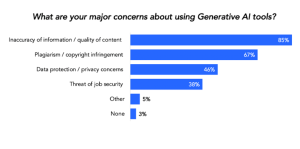
There is a fear and perception that ChatGPT and other forms of artificial intelligence (AI) could lead to job losses in newsrooms and be potentially dangerous if let loose without a leash. At the same time, however, there is a general consensus that if used judiciously, AI, combined with data, can be beneficial to news media organizations.
At least this is the general refrain if one goes by the Wan-Ifra conferences in Delhi and Vienna earlier this year, the INMA World News Congress in New York in May, and multiple examples from across the world – which point to the increased use of data and AI in newsrooms to improve productivity and workflow, gain reader insight, retain and target audiences, and transform strategies – all of which help create a better product and generate revenue.
West takes the lead
While newsrooms in the West are already taking the lead in adopting AI, in India editorial teams are also discussing and debating how advanced tech can transform newsroom strategies. At the Wan-Ifra Digital Media Europe event held in Vienna, newsroom leaders illustrated examples of generative AI’s transformative powers and how it is part of the larger story in Web 3.0.
As Ezra Eeman, director of Strategy and Innovation at NPO, the Dutch Public Broadcaster, and former Change director at international media company Mediahuis, puts it, “You could think of it as either a vitamin or a painkiller. There’s a lot of pain and friction in newsroom workflows that AI can relieve; and in terms of reader personalization, AI is actually a painkiller. It can unlock new forms, new kinds of services, and value.”
Wan-Ifra reports how Mediahuis an international media group with a range of strong brands and activities such as newspaper and magazine publishing, distribution, printing, TV, radio, and online media in diverse European countries, approaches AI. As Eeman explained, the group has various teams simultaneously or in parallel, approaching AI across the board, from data and insights to subscriptions.
It seems that there is an ongoing free-for-all with no publisher risking all its eggs in one basket. Ippen Digital Media, a German media company, has TygerGraph, a scalable graph database, for behavioral patterns, and Aleph Alpha for various newsroom tasks such as AI-assisted headlines. In addition, it uses ChatGPT for input in social media articles, quizzes, and listicles, and Midjourney for active image generation.
Similarly, at the Wan-Ifra Digital Media India held in Delhi this March, leading media organizations from the West demonstrated how AI, data, and creative intelligence tools have helped journalists and newsrooms engage with readers and ensure a better workflow and decision-making.
If Konstantinos Zachos, Chief Technology officer of CebAI, demonstrated how a creative AI-based intelligence tool helps journalists discover new angles to stories and connect diverse voices, Janni Frederiksen Kalafatis, User experience lead, Verdens Gang (VG), Norway’s premier news source, explained how they are retaining young users by using AI to tailor articles to suit their needs.

Saemmool Lee, head of Digital Innovation of Dong-A Ilbo, South Korea’s leading media group, underlined the importance of data to harness and engage new readers. The media group focuses on biweekly stakeholders’ meeting that involves the strategy office, newsroom, and various platforms to share what’s been done for the past two weeks – ideate what should be done next and how to do it – and talk about long-term vision and assignments.
Other strategies include reviewing the data such as clicks, conversions, and engagements; producing a monthly ‘performance report’ for news content shared with top decision makers. Personalized reports on audience data along with analysis and advice, are also provided, Lee explained.
The Indian view
As far as the Indian media is concerned, though there has been enough emphasis on the use of data harnessing and converting for newsroom strategies, there is a certain amount of caution when it comes to AI as there is this general feeling or perhaps a well-founded fear that artificial intelligence has no conscience, which is an essential part of intelligence.

There are others, however, who feel AI may not necessarily be a monster if used judiciously and under human supervision as tech, they said, is a means and not an end by itself. Yudhvir Mor, HT Media’s Chief Product & Technology officer, emphasizes that the use of AI in content management systems (CMS) can help in content analysis and creation, translation, image recognition and tags, and real-time SEO assistance but with checks and balances.
Vivek Pandey, vice-president, Revenue Strategy, Times Internet spoke on how a real-time data pipeline across 360-degree business functions is essential for driving a pricing strategy. At Times, they use inventory data, audience data, market trends, content trends marketing trends using in-house and other tools.

Nagaraj Nagabushanam, vice-president, data and analytics, The Hindu, said new media companies sitting over large amounts of data are looking for ways to harness it for better decision-making. Setting up a strong data analytics team is vital for any news organization, Nagaraj said. “Use data to understand the audience, create more dynamic and personalized product experiences and evolve the business model through data-driven experimentation.” A data platform is needed for data consolidation, improved data quality, greater visibility; streamlined analysis, and enhanced collaboration, Nagaraj said.
Data science and AI have been used by Indian news publications for generating customer engagement and revenue from big tech search and social media platforms for several years. However, the role of data scientists was perhaps mistakenly downgraded in some dailies about five years ago, by publishers who found this type of research and analytical work too ‘expensive’ at least for the possibilities they perceived at the time.
At the Wan-Ifra Delhi meet, an interesting conversation took place between Siddharth Varadarajan, founding editor of The Wire, Sohini Guharoy, head of Audience Growth & Platforms, Network 18 Group, and Sunny Sen, founder, CEO, ConsCent.ai, a subscription management and analytics platform. The general consensus was that such tools free up trained human resources for more productive content-related work, enhance the discovery of news, optimize resources and human skills, analyze data, get real-time insights on user behavior, and target and optimize ads.
“Tech opens up new avenues. There is a fear among journalists no doubt but ChatGPT can help make informed choices that Google can’t. AI can be used to make up for the absence of journalists and generate story ideas, which humans can always vet. Of course, we have to figure out the ethical challenges posed by artificial intelligence,” Varadarajan said.

For Nikhil Pahwa, the founder of MediaNama, a mobile and digital news portal – technology such as AI has a big role in Web 3. Creators of AI have to think of ways and means to use AI to address click rates, check fake news and track down its original source, map people, places, and events, build communities around content, and ensure creator and publisher rights among other tasks, Pahwa emphasized.
Notes of caution, discomfort, and comfort
Apart from the fear of job losses, misinformation, the lack of guidelines, errors, biases, transparency, and plagiarism because of the use of AI are some of the other concerns raised at multiple events and by newsroom leaders and tech specialists.
Listing what he says are the pros and cons of artificial intelligence, Nivash Jeevanandam, a senior research writer at INDIAai, a joint venture by MEITY, NEGD, and NASSCOM, quotes various surveys that show how newsrooms are already using AI.
One report by Digital Information World that surveyed 71 news organizations in 32 countries says 61% of newsrooms are using AI to make journalists’ work more efficient while 45% wanted to deliver more relevant content to users. Another report from Reuters says 59% are using AI to improve content, 39% to automate workflows, and 31% to help journalists find better stories.

The brighter side of AI, Jeevanandam says, includes increased efficiency and scalability, consistency, and cost-effectiveness, and improved quality. AI can also help in data analysis, fact-checking, content generation, translation, art generation, and transcription. The flip side, he said, is a lack of creativity, chances of plagiarism, lack of emotional intelligence, limited contextual understanding, no ethical considerations, and human connection.
No guidelines in place
Some of the fears over AI may not be unfounded. A survey by Wan-Ifra says nearly half of newsrooms (49%) use generative AI tools but only 20% have guidelines in place. The inaccuracy of the information and the quality of content is the number one concern among publishers when it comes to AI-generated content. 85% of survey respondents highlighted this as a specific issue. 67% feared plagiarism while 46% raised data protection and privacy concerns. 38% feared job security.

Robert Thomson, CEO at News Corp, told the INMA meeting that generative AI is a real threat to journalism in three main ways – “Content is being harvested and scraped to train AI engines; Individual stories are being surfaced in specific searches; and, Original journalism can be synthesized and then presented as distinct in the form of super snippets.” To tackle plagiarism, Thomson says journalists and media companies have to remain vigilant as well as engage in advocacy of their interests.
The possible use of AI and deep fakes to spread misinformation is another concern raised both at the INMA and Wan-Ifra meets.
“There is tremendous worry about the dangers generative AI poses to the work of journalists. Not only is AI capable of generating content that can compete with the work of actual journalists, but it can also be used to disseminate misinformation and create deep fakes that are difficult to recognize,” Karen Silverman, CEO and founder of the Cantellus Group, said at the INMA meet.
Speakers at the Delhi Wan-Ifra meeting raised similar concerns. Siddharth Varadarajan raised the issue of bad actors using A-I to target genuine actors and the spread of misinformation.
Speaking at the INMA New York meet, Praveen Someshwar, managing director and CEO of HT Media, more or less summed it up. “Generative AI is going to change the way content gets amplified and it’s going to change the way audiences consume it,” he said. “So it’s both an opportunity and a threat. The threat is that it is getting trained by the content we and others create, and we creators may not be rewarded in a balanced manner. If publishers and Big Tech can work together, there is a massive opportunity for both. But Big Tech has to share the spoils,” INMA reported Someshwar as saying.
















